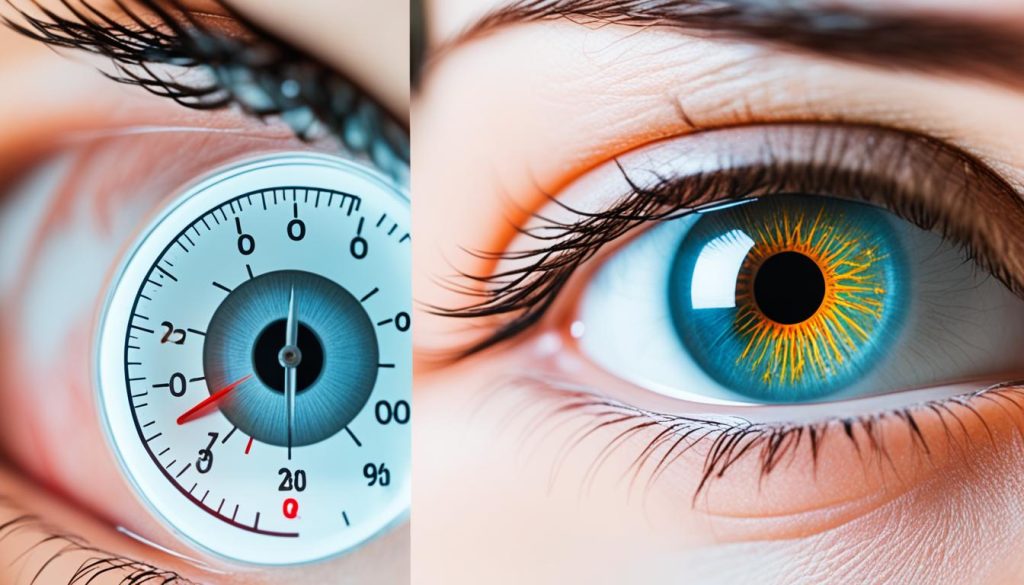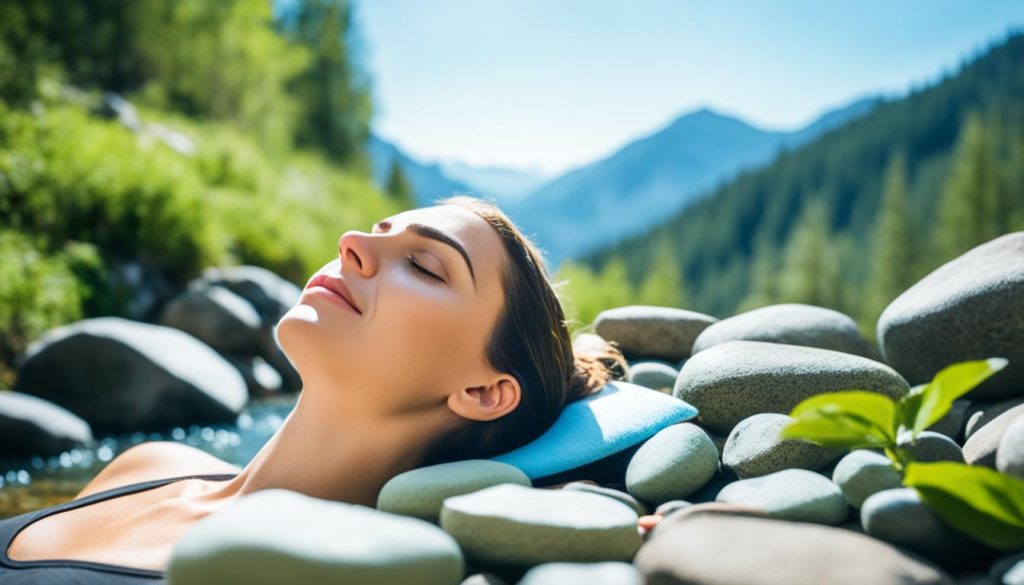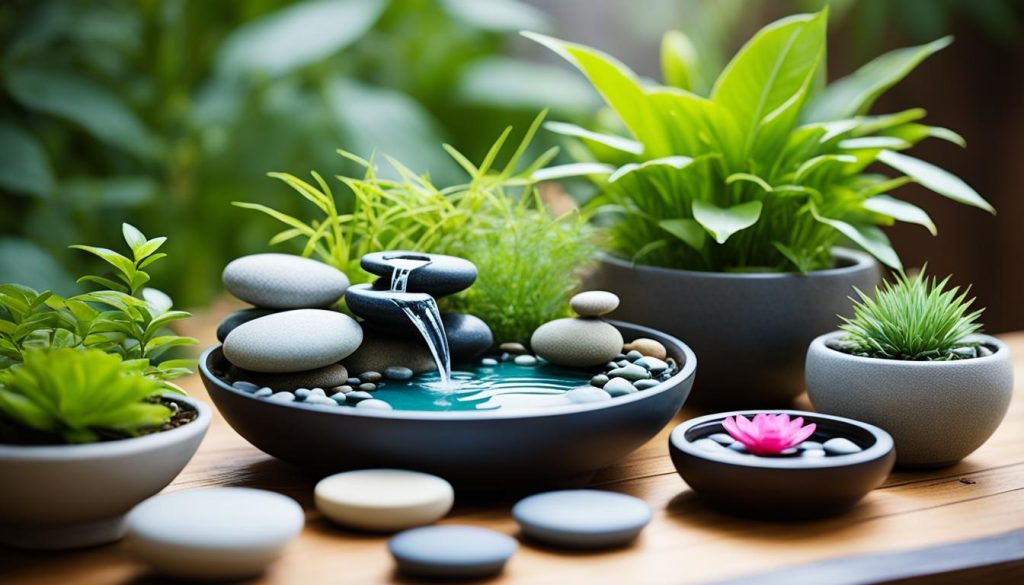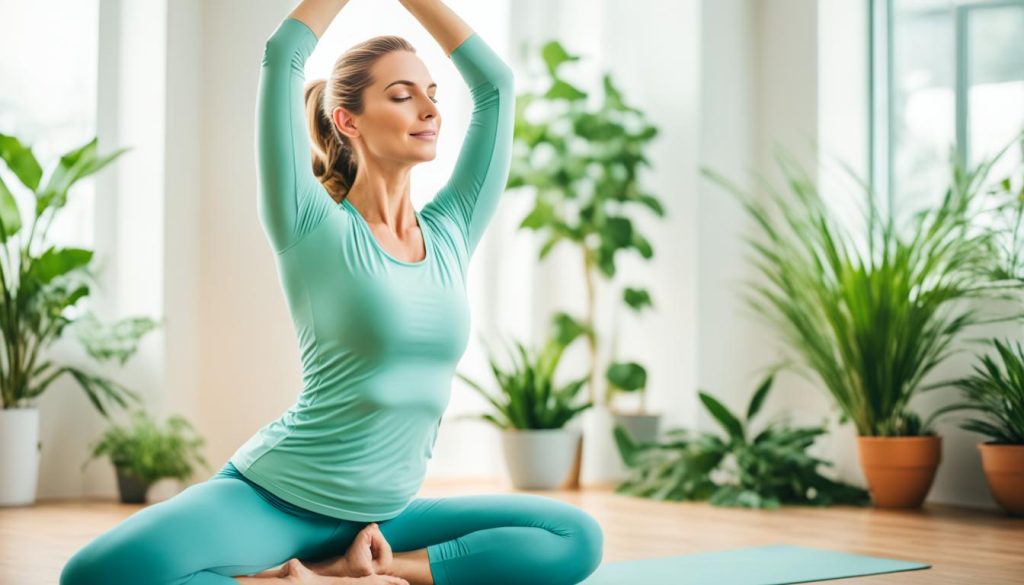Ocular hypertension is a condition in which the pressure inside the eye is higher than normal, without any damage to the optic nerve. It is important to see a healthcare provider and follow their recommendations for medications and regular eye exams. Studies show that approximately 3-6 million people in the United States, including 4%-10% of the population over 40 years old, have intraocular pressures of 21 mmHg or higher, which is considered ocular hypertension.
Although most people with ocular hypertension do not have any symptoms, it is crucial to undergo regular eye examinations to detect any damage to the optic nerve. Ocular hypertension should not be considered a disease by itself, but it increases the risk of developing glaucoma. It is estimated that 3 million people in the United States have glaucoma, and more than 120,000 are legally blind due to this disease.
There are various factors that contribute to high eye pressure, and fortunately, there are natural ways to reduce it. In this article, we will explore the causes of high eye pressure and provide relief strategies to help you maintain healthy eyesight. Learn more about what causes high eye pressure, how to reduce high eye pressure naturally, and discover effective ways to lower eye pressure through natural remedies.
Join us as we uncover the factors behind high eye pressure and explore techniques for reducing eye pressure naturally. Let’s take a closer look at what causes high eye pressure and how you can find relief.
What Causes High Eye Pressure and How to Reduce It?
High eye pressure, also known as ocular hypertension, occurs when there is an imbalance in the production and drainage of fluid within the eye. The channels responsible for draining the fluid may not function properly, resulting in an accumulation of fluid and increased pressure.
Several factors can contribute to high eye pressure:
- Age: As we age, the risk of developing high eye pressure increases. It is more common in individuals over the age of 40.
- Thin Corneas: People with thinner corneas may have a higher risk of elevated eye pressure.
- Ethnicity: Certain ethnicities, such as African Americans, have a higher prevalence of high eye pressure.
- Gender: Women may be at a higher risk of high eye pressure after menopause.
- Family History: Individuals with a family history of glaucoma or high eye pressure have an increased likelihood of developing ocular hypertension.
It is important to note that having high eye pressure does not guarantee the development of glaucoma, but it does increase the risk. Managing and reducing high eye pressure is crucial for maintaining good eye health and preventing further damage.

| Risk Factors | Description |
|---|---|
| Age | Increases the risk, particularly in individuals over the age of 40. |
| Thin Corneas | Individuals with thinner corneas may have a higher risk of elevated eye pressure. |
| Ethnicity | Certain ethnicities, such as African Americans, have a higher prevalence of high eye pressure. |
| Gender | Women may be at a higher risk of high eye pressure after menopause. |
| Family History | Individuals with a family history of glaucoma or high eye pressure have an increased likelihood of developing ocular hypertension. |
Natural Remedies to Lower Eye Pressure
If you’re looking for natural ways to reduce eye pressure, there are several remedies and lifestyle adjustments that can help. These natural approaches can complement medical treatments and contribute to maintaining healthy vision. Here are some strategies to consider:
1. Eye Exercises
Engaging in specific eye exercises can help reduce eye pressure. These exercises often focus on strengthening the eye muscles and improving circulation in the ocular region. Examples include:
- Blinking exercises: Blinking rapidly for a few seconds every hour can help lubricate the eyes sensitive and relieve strain.
- Eye rotations: Gently moving your eyes in clockwise and counterclockwise circles can help relax the muscles and promote healthy blood flow.
- Focusing exercises: Shifting your focus between near and distant objects can improve eye flexibility and reduce eye strain.
2. Stress Reduction
Chronic stress can contribute to increased eye pressure. Implementing stress-reducing practices can help lower overall tension and promote eye health. Consider incorporating activities such as:
- Meditation: Practicing mindfulness and deep breathing exercises can help alleviate stress and promote relaxation.
- Yoga or tai chi: Engaging in gentle physical exercises can reduce stress levels and improve overall well-being.
- Art or hobbies: Engaging in creative activities can provide a sense of joy and help divert attention from stressors.
3. Nutritional Supplements
Certain nutritional supplements have shown promise in supporting eye health and reducing eye pressure. Talk to your healthcare provider before starting any new supplements, but some options that may be beneficial include:
- Omega-3 fatty acids: Found in fish oil and flaxseed oil, omega-3s have anti-inflammatory properties that may help lower eye pressure.
- Vitamin C: This antioxidant vitamin can support overall eye health, including reducing eye pressure.
- Bilberry extract: Rich in antioxidants, bilberry extract may help improve blood flow and support eye health.
4. Lifestyle Adjustments
Simple lifestyle changes can also have a positive impact on eye pressure. Consider implementing the following adjustments:
- Manage your screen time: Take regular breaks when working or using digital devices to reduce eye strain and give your eyes a rest.
- Avoid smoking: Smoking can contribute to increased eye pressure and further complications, so quitting smoking is highly recommended.
- Maintain a healthy weight: Excess weight can potentially increase eye pressure, so aim for a balanced diet and regular exercise to maintain a healthy weight.
Remember, while these natural remedies may help reduce eye pressure, it is essential to regularly visit your eye care provider for comprehensive eye exams and follow their recommendations. They will be able to provide personalized guidance and monitor your eye health effectively.
| Natural Remedies | Benefits |
|---|---|
| Eye exercises | Strengthen eye muscles, improve circulation |
| Stress reduction | Lower tension, promote relaxation |
| Nutritional supplements | Support eye health, reduce inflammation |
| Lifestyle adjustments | Reduce eye strain, promote overall health |

Medications for Lowering Eye Pressure
In some cases, medication may be necessary to lower eye pressure. Eye drops are commonly prescribed to help reduce intraocular pressure. There are different types of eye drop medications available, such as prostaglandins, beta blockers, alpha-adrenergic agonists, carbonic anhydrase inhibitors, and rho kinase inhibitors. These medications work by either improving fluid drainage or reducing fluid production in the eye. The specific medication and dosage will depend on the individual’s condition and the severity of their eye pressure. It is important to follow the healthcare provider’s instructions for proper application and compliance with eye drop medications.

Eye drops are a common form of medication for lowering eye pressure. Each type of eye drop medication targets a specific mechanism to reduce intraocular pressure. Let’s take a closer look at the different types of eye drop medications:
| Type of Eye Drop Medication | How It Works |
|---|---|
| Prostaglandins | Increase fluid drainage from the eye. |
| Beta Blockers | Decrease fluid production in the eye. |
| Alpha-Adrenergic Agonists | Decrease fluid production and increase fluid drainage. |
| Carbonic Anhydrase Inhibitors | Reduce fluid production in the eye. |
| Rho Kinase Inhibitors | Relax the eye’s tissues to improve fluid drainage. |
It is important to consult with a healthcare provider to determine the most suitable eye drop medication for your specific situation. They will consider factors such as your medical history, current medications, and any existing eye conditions. Proper application and compliance with the prescribed eye drop medication are vital for effectively lowering intraocular pressure.
Eye Drop Administration Tips:
- Wash your hands before applying eye drops.
- Tilt your head back and pull down your lower eyelid to create a small pocket.
- Squeeze the prescribed number of eye drops into the pocket without touching the eye or eyelid with the dropper tip.
- Carefully close your eyes for 1-2 minutes to allow the eye drops to spread evenly over the eye’s surface.
- Apply gentle pressure to the inner corner of the eye to prevent the medication from draining into the tear duct.
- If you are using multiple eye drop medications, wait at least 5 minutes between each application to ensure proper absorption.
- Follow the recommended dosage and frequency as prescribed by your healthcare provider.
Regular follow-up visits with your eye care professional are essential to monitor the effectiveness of the prescribed medication and make any necessary adjustments. In some cases, additional treatment options, such as surgical interventions, may be considered if the medication alone does not sufficiently lower the intraocular pressure.
Surgical Options for High Eye Pressure
In some cases, surgical intervention may be necessary to lower high eye pressure. There are several surgical options available for treating high eye pressure, each with its own benefits and considerations.
Laser Therapy
Laser therapy is a common technique used to improve fluid drainage in the eye, helping to reduce high eye pressure. During the procedure, a laser is used to target specific areas of the eye, allowing for better drainage and regulation of intraocular fluid. Laser therapy is often a minimally invasive procedure, with quick recovery times and minimal side effects. It is commonly used for open-angle glaucoma, a form of high eye pressure.
Filtering Surgery (Trabeculectomy)
Filtering surgery, also known as trabeculectomy, is another surgical option for reducing high eye pressure. This procedure involves creating a small opening in the white part of the eye, allowing excess fluid to drain out more effectively. By creating an additional space for fluid to leave the eye, filtering surgery can effectively lower intraocular pressure. Trabeculectomy is a more invasive procedure compared to laser therapy, but it can be highly effective in managing high eye pressure.
Drainage Tubes
Drainage tubes, or glaucoma drainage devices, can be inserted into the eye to facilitate the drainage of excess fluid. These small tubes provide an alternative path for fluid to leave the eye, reducing the overall pressure. Drainage tubes are commonly used in cases where other surgical options have been unsuccessful or when there are specific anatomical considerations. The insertion of drainage tubes is a more complex procedure and requires close monitoring by an ophthalmologist.
Minimally Invasive Glaucoma Surgery (MIGS)
Minimally invasive glaucoma surgery, or MIGS, is a category of surgical procedures that offer less invasive options for lowering high eye pressure. These procedures are typically performed alongside other eye surgeries and are designed to have minimal impact on the eye’s anatomy. MIGS procedures may involve the use of implants or stents to improve the fluid drainage process. They often have shorter recovery times and fewer complications compared to traditional surgical methods.
The choice of surgical option for high eye pressure depends on various factors, including the individual’s specific condition, the severity of their eye pressure, and the recommendation of their healthcare provider. It is essential to consult with an ophthalmologist who can evaluate the individual’s eye health and recommend the most appropriate surgical approach.
Lifestyle Tips for Eye Pressure Management
In addition to natural remedies and medications, certain lifestyle adjustments can help in managing eye pressure. Incorporating these lifestyle tips into your daily routine can contribute to better eye health and reduce the risk of complications associated with high eye pressure:
- Get regular exercise: Engaging in regular physical activity not only benefits your overall health but can also help in managing eye pressure. Activities like walking, jogging, yoga, or swimming can improve blood circulation and promote better fluid drainage in the eyes.
- Practice stress management: Stress can contribute to increased eye pressure. Incorporating stress management techniques like deep breathing exercises, meditation, or engaging in hobbies can help reduce stress levels and promote better eye health.
- Follow a balanced diet: A well-balanced diet rich in fruits, vegetables, whole grains, lean proteins, and omega-3 fatty acids can support overall eye health. Include foods like leafy greens, citrus fruits, oily fish, nuts, and seeds in your diet to provide essential nutrients that help in reducing eye pressure.
- Avoid excessive caffeine and alcohol: Consuming excessive amounts of caffeine and alcohol can increase eye pressure. Limit your intake of caffeinated beverages like coffee, tea, and energy drinks, as well as alcoholic beverages, to help manage eye pressure more effectively.
- Practice proper eye hygiene: Taking care of your eyes is crucial in managing eye pressure. Avoid rubbing your eyes, use prescription eyewear if required, and ensure good hygiene practices when using contact lenses, as these habits can help prevent further eye complications.
Remember, these lifestyle tips should supplement medical advice and regular eye check-ups from healthcare professionals. By incorporating these practices into your daily routine, you can actively contribute to better eye pressure management and overall eye health.

Dietary Tips for Lowering Eye Pressure
In addition to natural remedies and lifestyle adjustments, maintaining a healthy diet can help lower eye pressure and promote overall eye health. Certain foods contain nutrients that are beneficial in reducing high eye pressure. By incorporating these foods into your diet, you can actively manage your eye pressure levels.
1. Leafy Greens
Eating leafy greens like spinach, kale, and collard greens can support eye health and reduce eye pressure. These vegetables are rich in nutrients such as vitamins A, C, and E, as well as antioxidants like lutein and zeaxanthin, which have been linked to lowered eye pressure and decreased risk of glaucoma.
2. Citrus Fruits
Citrus fruits like oranges, grapefruits, and lemons contain high levels of vitamin C, which can help lower eye pressure. Vitamin C is known for its antioxidant properties and its potential to reduce the risk of glaucoma. Incorporating these fruits into your diet can be refreshing and beneficial for your eyes.
3. Omega-3 Fatty Acids
Foods rich in omega-3 fatty acids, such as fatty fish (salmon, mackerel, and tuna), walnuts, and flaxseeds, can help lower eye pressure. These healthy fats have been shown to decrease inflammation and promote proper drainage of fluid in the eye, which can contribute to reducing high eye pressure.
4. Nuts and Seeds
Nuts and seeds, including almonds, pistachios, sunflower seeds, and chia seeds, are packed with vitamins, minerals, and antioxidants that support eye health. These nutrient-dense snacks can be a tasty and convenient way to incorporate eye pressure-lowering foods into your daily routine.
5. Garlic
Garlic contains compounds that have shown potential in reducing eye pressure. Incorporating garlic into your meals, whether in its raw or cooked form, can provide you with the potential benefits of this natural remedy.
Remember to consult with a healthcare professional or nutritionist before making any drastic changes to your diet. They can guide you on the appropriate portion sizes and dietary requirements for managing your eye pressure effectively.
Eye Pressure-Lowering Foods
| Foods | Nutrients | Potential Benefits |
|---|---|---|
| Leafy Greens | Vitamins A, C, E, lutein, zeaxanthin | Reduce eye pressure, decrease glaucoma risk |
| Citrus Fruits | Vitamin C, antioxidants | Lower eye pressure, reduce glaucoma risk |
| Omega-3 Fatty Acids | Healthy fats | Decrease inflammation, promote proper drainage |
| Nuts and Seeds | Vitamins, minerals, antioxidants | Support eye health, lower eye pressure |
| Garlic | Beneficial compounds | Potential to reduce eye pressure |
Conclusion
High eye pressure, also known as ocular hypertension, can significantly increase the risk of developing glaucoma, a leading cause of vision loss. However, there are effective and natural ways to manage and reduce high eye pressure. By incorporating natural remedies, making lifestyle adjustments, and following a balanced diet, individuals can take proactive steps to lower their eye pressure and maintain healthy vision.
Reducing high eye pressure naturally involves a holistic approach. Regular eye care and monitoring by healthcare professionals are essential for proper eye pressure management. By seeking professional advice and adhering to their recommendations, individuals can effectively monitor and control their eye pressure to prevent further damage.
Remember, the quest to reduce high eye pressure and maintain eye health is an ongoing process. With the right combination of natural remedies, lifestyle adjustments, and professional guidance, individuals can take charge of their eye pressure management and preserve their precious vision for years to come.
FAQ
1. What causes high eye pressure?
High eye pressure, or ocular hypertension, is caused by an imbalance in the production and drainage of fluid in the eye. Factors that contribute to high eye pressure include age, thin corneas, certain ethnicities, gender, and a family history of glaucoma.
2. How can I reduce high eye pressure naturally?
There are natural remedies and lifestyle adjustments that can help lower eye pressure. These include regular exercise, stress management, avoiding smoking and excessive alcohol consumption, and using warm compresses on the eyes.
3. What are some ways to lower eye pressure?
In addition to natural remedies, there are medications available, such as eye drops, that can help lower eye pressure. Surgical options, such as laser therapy and filtering surgery, may also be considered in certain cases.
4. Are there any natural remedies for high eye pressure?
Yes, natural remedies for high eye pressure include consuming Omega-3 fatty acids, drinking green tea, and taking supplements like vitamin C, vitamin E, and ginkgo biloba.
5. How do I lower intraocular pressure?
Lowering intraocular pressure can be achieved through a combination of natural remedies, medication, and in some cases, surgical intervention. It is important to work closely with your healthcare provider to determine the most suitable treatment plan for your specific condition.




